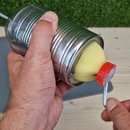Introduction: Buzz Wire Game 2.0
In this Instructable I show you how to make a Buzz Wire Game 2.0. The difference between the traditional Buzz Wire Game and the 2.0 version is that with this version 2 wires are used at the same time. The rings are connected with scissors. This makes the game a lot more challenging and difficult.
There are already several Instructables on how to make a buzz wire game. For example https://www.instructables.com/Buzz-Wire-Kit/. The addition to this Instructable is the double wire. That's why this Instructable is also participating in the remix contest.
Challenges
The biggest challenge in this project was getting the threaded rods to size properly. Because the scissors only have a certain range, the distance between the 2 threaded rods should not be outside this tolerance. The bends must be well rounded, I solved this by bending the threaded rods over a round tube.
Video tutorial:
Components:
- Plastic plate 280mm x 250mm x 6mm (can be replaced by cardboard or wood)
- 4 AA batteries
- AA battery holder for 4 AA Batteries
- On-off switch
- Buzzer
- Scissors
- 2 x M5 threaded rod 1000 mm
- 10 M5 nuts
- 8 M5 washers large
- 2 M5 washers small
- 1 meter cable
- 1 M4 bolt 10mm
- Heat shrink tubing
Step 1: The Base
For the base I used a black plastic plate of 6 mm thick. For this I made a mold. This template is included in this step as a PDF file (2 files). Instead of plastic sheet, wood or, for example, cardboard sheet can of course also be used. If you are using the mold and the material has a different thickness, you have to take this into account.
Cut the parts for the base to size. Make the holes for the switch, buzzer and wire. This is a lot easier for mounting the base than afterwards. Glue the plastic parts together with a little hot glue. Use a little glue to set the plates in position and then glue them securely.
Attachments
Step 2: Assemble the Electrical Components
When the base has hardened properly, the electrical components can be placed.
Battery holders
Start with the 2 battery holders. Because the buzzer I used is recommended between 5 and 8 volts, I opted for 4 AA batteries. I don't think a 9V battery would be a problem either, but perhaps the buzzer's lifespan would deteriorate considerably. Mount the 2 battery holder into the base with a little hot glue.
On-off switch
Then place the on / off switch in the recess. If it is perfectly tailored, the switch will clamp itself. Unfortunately this was not entirely the case with me and I had to use a little super glue.
Buzzer
The buzzer is not fixed in this step. If it is already mounted, you will no longer get to the connectors properly and connecting the cabling will be difficult.
Step 3: Connect Cabling
Most of the cabling can already be connected. (See simple wiring diagram)
- Solder the black (-) cable from battery holder 1 to the red (+) cable from battery holder 2.
- Solder the black (-) cable from battery holder 2 to a connector of the on / off switch.
- Solder a cable between the other connector of the on off switch and the buzzer (negative side) (The long pin on the buzzer is +, the short pin on the buzzer is -)
- Solder the cable that goes to the scissors to the buzzer (positive side)
- Mount a ring terminal on the cable for the scissors
- Mount a ring terminal on the red (+) cable of battery holder 1
The cable to the scissors and the (+) cable for the scissors will be connected later in the project.
Before proceeding, test that the circuit is working. Place the AA batteries in the holders, turn the on / off switch to on and hold the 2 ring terminals together. The buzzer should now beep.
Step 4: Create the Wire Maze
To create the wire maze in this project I used M5 threated rod. This is bent with the help of a round tube. First I made the innermost. After this the outer adapted to it. It is important that the distance between the 2 wires can be bridged by the scissors, it is of course not the intention that the game becomes impossible.
In this step you can let go of your imagination and make a beautiful creation.
The wire maze is not installed yet. For this, the scissors must first be prepared, this is described in the next step.
Step 5: Prepare the Scissors
The scissors will function as a double loop.
To begin with, the wire prepared in step 3 is connected to the scissors. Drill a 3 millimeter hole in the scissors in a position that will not prevent the scissors from functioning. Tap M4 thread into the hole. I used an M4 combination drill and tap bit. Mount the power wire to the scissors with a short M4 bolt and a washer. As a double loop I used 2 M10 washers. This is also possible with other conductive objects such as a key ring or an iron wall hook.
Mount the 2 rings on the 2 ends of the scissors with a little super glue. Make sure the metal of the ring makes good contact with the metal of the scissors.
Step 6: Assemble the Parts
Place all parts roughly in position to keep the assembly organized. Slide the scissors with the 2 rings over the screw thread.
A piece of heat shrink tubing is placed over the 4 ends, this is used later to make the rest position of the scissors. Now turn a nut on the 4 ends of the screw thread and add a washer. Place the whole in the plastic base and secure the 4 ends with a washer and a nut. Slide the heat shrink tube in position (also over the top nut) and crimp it.
Connect the red cable from the battery holder to the threaded rod. Make a short piece of cable and connect the 2nd wire rod to the first. Secure with 2 nuts.
Step 7: Ready!
The game can now be played. As expected, it is quite a difficult task to pass it in one go, but after a number of practice it is possible. To make it easier, a resting position can be created in several places by mounting extra heat shrink tubing.
Video tutorial:
Good luck making the Buzz Wire 2.0 game! I am very curious about your creations and I think it is great if they are posted here!
Stay healthy and see you soon!
New Pew






